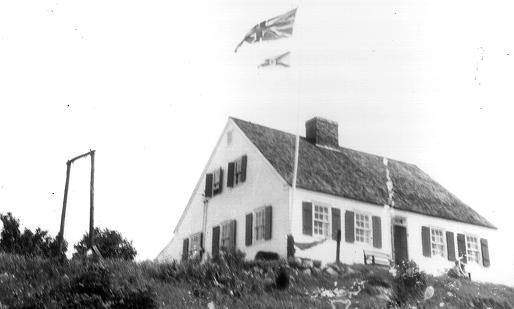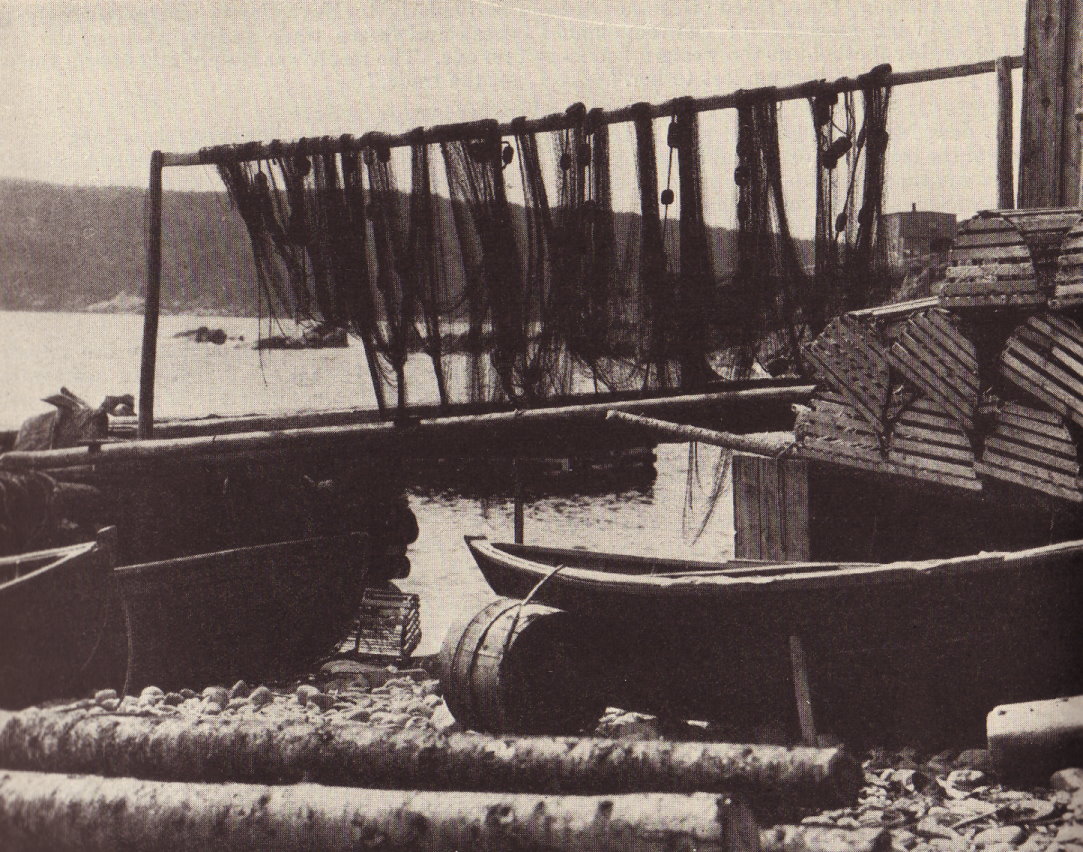Chapter Six, Hackett's Cove
"Ever since I was a small child, the sea, and a ship sailing on the sea, and nearly all the things that belong to the sea, have had for me a poignant fascination. The sights and sounds and odours of sailing ships, with the memories of harbours and wharves, seem woven into my mental texture." (Henry Havelock Ellis)I am not sure when my parents purchased "Hill-Top-House," likely in 1939. Though my folks had a summer place on McGrath Lake, before I was born; however, it was determined to look for a place on the seacoast. They located an old farm overlooking Hackett's Cove. The story I heard was that they made an offer to purchase the place but the owners would not sell for the price offered. My father walked away. Within the week, a hurricane swept through the region. My father decided to drive down to see how the old farm fared. The 19th century house stood the winds, but many of the out buildings were in ruins. My father re-offered the price (but a few hundred) and the owners accepted. The house had fields and a large woodlot which extended inland. The land sloped to Highway #333 (as now known) then but a dirt road that ran along the eastern shores of St Margaret's Bay. The lands included a piece across the road on the shore next to Raymond Covey's wharf and fishing shed (we will have more to say about Raymond, a man of many talents). No one asserted exclusive rights to the shore; fishermen have long used the shores in order to prosecute their business and no one bothered anyone else.
At the first of 1941, before my birth, the family lived on Dublin Street at Halifax. I think they needed more bedrooms; so, they had the house on Quinpool Road built. It took a while for the house to get built, such that the family moved to Hackett's Cove where they spent the winter. My older brothers and sisters went to the one-room schoolhouse at Hackett's Cove for that year (1941-2).
From my infant-hood through to 1949, I spent my summers there at Hackett's Cove. It was in 1949 that the place was sold as another place was found at Hubbards, "The Shoals" -- we will come to this in our next chapter. These were tender years, and I have but a few memories of Hackett's Cove.
The most distinct memory I have is waking early to the wonderful sound of the Make And Break Engines, affectionately referred to as "One Lungers." More than one wooden boat would be making their way out of the cove with their distinctive sound echoing and reechoing from the sloping hills encasing the cove ("Putt," - "Putt," - "Putt" ...) I remember looking out over the cove and see in the distance the boats rounding the point. The scene would often include, at some distance off, a fisherman pounding away on a piling or a hunk of metal. I could see the man come down with his mallet and to hear the "bang" a second later; I wondered why the delay?
At the backdoor was a bucket with live trout swimming in it; Raymond Covey had caught them on a back lake and left them there for my mother. I remember, too, on another occasion that I was to sleep out, with my brother, in one of the little outbuildings that had been fitted out with a rough set of bunks. Wow! To sleep out like that. I crawled into the bedding, to sleep soundly, very soundly, such that I woke up in the house in my regular bed to which, for some reason, I was carried at some point through the night.
The outstanding family names in the Hackett's Cove area, are: Hubley, Fralick, Covey and Boutilier. I remember Raymond Covey. I was totally fascinated with the man. This Covey family lived below us on the slope to the left. Raymond was the epitome of the independent Nova Scotian fisherman. He fished alright, and did all the things necessarily connected with this activity -- goin' to town was expensive. Raymond built his boat in his free-standing shop in his yard. No one was concerned if a little blond boy should wonder into his shop and observe him working. I wondered, but I did not speak up -- Raymond was quick with his short answers and one was never quite sure what would come out of his mouth. What I wondered was how he was to get this large wooden boat through the double doors of his shop. I found out when it was time to get the boat to the shore; the side of the building was deconstructed. Inside the shop was a blacksmith's corner with a forge, and around it, pieces of iron in various forms. The man made everything. There I was looking on, silently observing the glowing coals as the man worked his metal pieces, displaying, in his every movement, the complete confidence he had in his work, work that would keep himself safe at sea. Not just in his shop did I make my observations. I saw him notch logs to be fitted together to further strengthen his wharf upon which his fishing hut was constructed. Down would come the axe cutting into the end of the log; up it went again; then down with a firm stroke to hit the cut he had just made, dead-on. Then up again, then down, slicing to one side of the cut just made, then up and down to the second cut and a chip would fly away leaving a perfect notch to be fitted to another notch in another log.
Another event which I watched in fascination was when Raymond gutted the fish on the wharf. Things flew and I kept well clear as the fish was relieved of its guts and head in one slice of the knife. The result of this one slice would reduce the fish into three pieces: guts and head, a red piece coming from the gut (its liver), and the split fish itself. As Raymond completed his stroke, all three pieces would fly through the air in three different directions: the guts to the cove, immediately ready to be consumed by the squawking flock of waiting seagulls; the liver into an oily, stinking barrel nearby, and; the split fish to the accumulating pile in a large wooden box with rope handles. Around this fishing hut on the shore were wooden flakes on which the split and salted cod was laid out for the wind and sun to dry.
Raymond had a sizable fishing boat fitted with the then ubiquitous Make & Break engine. He was one of those early morning fishermen to which I had previously referred. They would be on the sea early, and were often home before the morning was out. There was an old fisherman by the name of Sherman (I believe another Covey) who rowed his dory out of the cove and out into the bay to his fishing spot. There was no licences or regulation required; the government had little or no involvement in the activities of these intrepid seafarers. No one had to draw a map as to where their fishing spot was, they learned from their fathers on how to get out there and get back, quite on their own. Importantly, everyone knew their invisible boundaries on the sea. Families fished their spot and all the fishermen knew where everyone else should be.
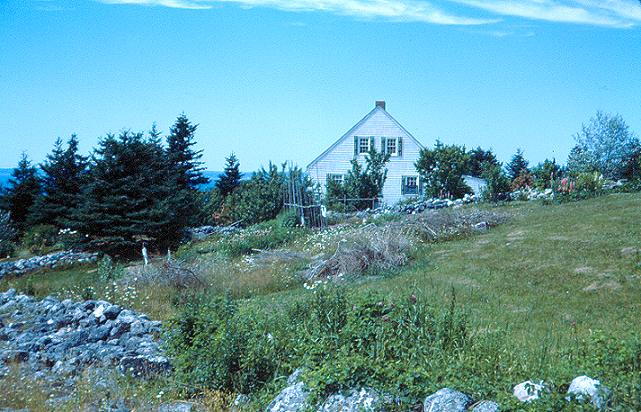
|
|
Hill-Top-House Looking North from the Lower Stonewall in the Orchard.
|
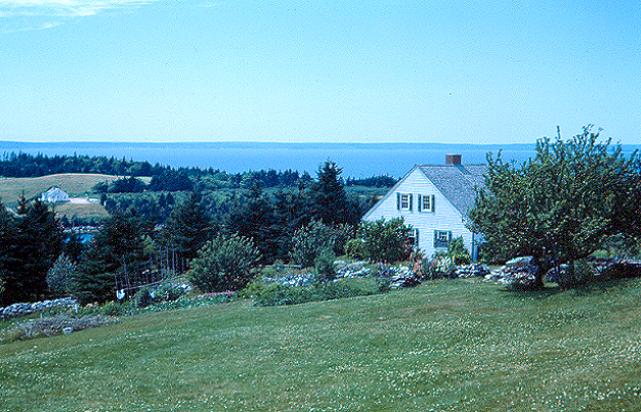
|
|
Looking North-West. Note St Margaret's Bay off in the distance and a little piece of the blue of Hackett's Cove. |
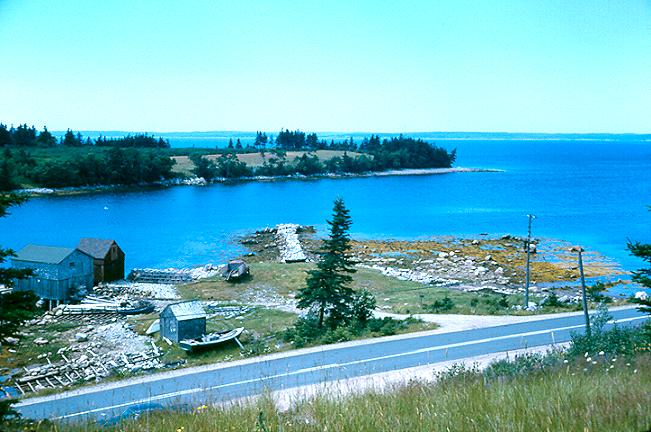
|
|
Looking Down the Slope just below Hill-Top-House. Raymond's fishing Hut and Wharf is the one to the far left. |
